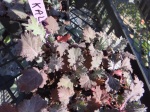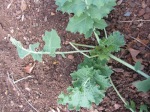
arugula
Jeanne provides an overview of the cultivated brassicas.
Two days after the re-election of Barack Obama, the arugula at the farmer’s market reminded me of John Schwenkler’s excellent commentary from the 2008 campaign season on political trends in food choices, taking issue with Republican opposition to arugula. Arugula was the subject of a gaffe by then-candidate Obama. Afterward the vegetable joined lattes in the pantheon of foodstuffs entirely in custody of liberals, according to some pundits on the political right.

broccoli
Arugula was not the only, or even the most recent, brassica (a species from the mustard family, Brassicaceae) to be dragged into the American political fray. Marion Nestle has a great commentary on two memorable instances when broccoli entered national political discourse, first when George H. W. Bush disavowed the vegetable, and then recently when Antonin Scalia turned the vegetable into a symbol of government imperialism during the Supreme Court’s consideration of the Affordable Care Act.

cabbage
In July 1948 Truman called both houses of Congress back from recess for what is now known as the Turnip Day Session, starting on, as he said, “what we in Missouri call Turnip Day,” the 25th of July. The designation comes from an old Missouri saying: “On the 25th of July, sow your turnips, wet or dry.” During World War I sauerkraut in the United States for a time became “Liberty cabbage,” a marketing predecessor to the Freedom Fries in the George W. Bush-era congressional cafeteria. The re-labeling came from American manufacturers of sauerkraut, the German name for the lacto-fermented salted cabbage popular in much of Europe and Asia, who worried that Americans would reject a product with a German name (incidentally, though smelly, making your own sauerkraut is easy and yields satisfying results).

watercress
The relative frequency of brassica appearances in political discourse reflects their abundance in the modern grocery cornucopia. In previous posts we discussed the numerous varieties of Brassica oleracea (including kale, collard greens, Chinese broccoli, Brussels sprouts, kohlrabi, cabbage, broccoli, and cauliflower) and other Brassica species (turnips, rutabagas, rapini, napa cabbage, tatsoi, bok choy, mizuna, mustard greens, mustard seeds, mustard or canola oil). This post completes our whirlwind tour of Brassicaceae food plant diversity. Continue reading →








